Quality of Low-Carbon Steel as a Distribution of Pollution and Fatigue Strength Heated in Oxygen Converter
Abstract
1. Introduction
2. Materials and Methods
- —average diameter of impurity, µm,
- —arithmetic average distance between impurities, µm,
- a, b—coefficients of the equation,
- V—relative volume of impurities, %,
- Vi—relative volume of impurities for the assumed its diameter, %.
- r—correlation coefficient,
- n—number of measurements.
3. Results
4. Discussion of the Research Results
5. Conclusions
Funding
Institutional Review Board Statement
Informed Consent Statement
Data Availability Statement
Conflicts of Interest
References
- Duc, M.L.; Thu, M.T. Application of Lean Six Sigma for Improve Productivity at The Mechanical Plant. A Case Study. Manuf. Technol. 2022, 22, 124–138. [Google Scholar]
- Anderson, C.W.; Shi, G.; Atkinson, H.V.; Sellars, C.M. The precision of methods using the statistics of extremes for the estimation of the maximum size of inclusions in clean steels. Acta Mater. 2000, 48, 4235–4246. [Google Scholar] [CrossRef]
- Jonšta, P.; Jonšta, Z.; Brožová, S.; Ingaldi, M.; Pietraszek, J.; Klimecka-Tatar, D. The Effect of Rare Earth Metals Alloying on the Internal Quality of Industrially Produced Heavy Steel Forgings. Materials 2021, 14, 5160. [Google Scholar] [CrossRef] [PubMed]
- Bricín, D.; Kříž, A. Influence of the Boriding Process on the Properties and the Structure of the Steel S265 and the Steel X6CrNiTi18-10. Manuf. Technol. 2021, 21, 37–44. [Google Scholar] [CrossRef]
- Dobrzański, L.A. Heat treatment as the fundamental technological process of formation of structure and properties of the metallic engineering materials. In Proceedings of the 8th Seminar of the International Federation for Heat Treatment and Sur-face Engineering IFHTSE, Dubrovnik, Croatia, 12–14 September 2001; pp. 1–12. [Google Scholar]
- Ivanytskyj, Y.L.; Lenkovskiy, T.M.; Molkov, Y.V.; Kulyk, V.V.; Duriagina, Z.A. Influence of 65G steel microstructure on crack faces friction factor under mode fatigue fracture. Arch. Mater. Sci. Eng. 2016, 82, 49–56. [Google Scholar] [CrossRef]
- Costa e Silva, A. Non-metallic inclusions in steels—origin and control. J. Mater. Res. Technol. 2018, 7, 283–299. [Google Scholar] [CrossRef]
- Yaguchi, H. Engineering Steels. In Encyclopedia of Materials: Metals and Alloys; Elsevier: Amsterdam, The Netherlands, 2022; pp. 153–161. [Google Scholar]
- Lipiński, T.; Ulewicz, R. The effect of the impurities spaces on the quality of structural steel working at variable loads. Open Eng. 2021, 11, 233–238. [Google Scholar] [CrossRef]
- Kasatkin, G.N. Effect of nonmetallic inclusions on the mechanical properties of hydrogenated steels. Mater. Sci. 2004, 40, 850–855. [Google Scholar] [CrossRef]
- Halford, G.L. Low Cycle Thermal Fatigue; NASA: Washington, DC, USA, 1986. [Google Scholar]
- Kalisz, D.; Migas, P.; Karbowniczek, M.; Moskal, M.; Hornik, A. Influence of selected deoxidizers on chemical composition of molten inclusions in liquid steel. J. Mater. Eng. Perform. 2020, 29, 1479–1487. [Google Scholar] [CrossRef]
- Zhang, L.; Pluschkell, W. Nucleation and growth kinetics of inclusions during liquid steel deoxidation. Ironmak Steelmak. 2003, 30, 106–110. [Google Scholar] [CrossRef]
- Zhao, Y.; Li, T.; Tang, G.; Gup, H.; Yan, J.; Gou, X.; Zhu, Y. Characterization of the morphological evolution of MnS inclu-sions in free-cutting steel during heating. J. Mater. Res. Technol. 2022, 17, 1427–1437. [Google Scholar] [CrossRef]
- Suresh, S. Fatigue of Materials; Cambridge University Press: Cambridge, UK, 1998. [Google Scholar]
- Lipiński, T.; Wach, A. Influence of inclusions on bending fatigue strength coefficient the medium carbon steel melted in an electric furnace. Prod. Eng. Arch. 2020, 26, 88–91. [Google Scholar] [CrossRef]
- Murakami, Y.; Kodama, S.; Konuma, S. Quantitative evaluation of effects of non-metallic inclusions on fatigue strength of high strength steels, I: Basic fatigue mechanism and fatigue fracture stress and the size and location of non-metallic inclusions. Int. J. Fatigue 1989, 11, 291–298. [Google Scholar] [CrossRef]
- Ulewicz, R.; Szataniak, P.; Novy, F. Fatigue properties of wear resistant martensitic steel. In Proceedings of the METAL 2014—23rd International Conference on Metallurgy and Materials, Brno, Czech Republic, 21–23 May 2014; pp. 784–789. [Google Scholar]
- Fan, Y.; Gao, G.; Gui, X.; Bai, B.; Yang, Z. Assessment of microstructure- and inclusion-induced fatigue crack initiation in bainitic/martensitic rail steels: Competing and synergistic effects. Int. J. Fatigue 2023, 173, 107706. [Google Scholar] [CrossRef]
- Srivastava, A.; Ponson, L.; Osovski, S.; Bouchaud, E.; Tvergaard, V.; Needleman, A. Effect of inclusion density on ductile fracture toughness and roughness. J. Mech. Phys. Solids 2014, 63, 62–79. [Google Scholar] [CrossRef]
- Lipinski, T.; Pietraszek, J.; Wach, A. Influence of oxygen content in medium carbon steel on bending fatigue strength. Eng. Rural. Dev. 2022, 21, 351–356. [Google Scholar]
- Yanase, K.; Endo, M. Multiaxial high cycle fatigue threshold with small defects and craks. Eng. Mech. 2014, 123, 182–196. [Google Scholar]
- Lipiński, T. Influence of non-metallic inclusions on bending fatigue strength of high-quality carbon constructional steel heated in an industrial electric arc furnace. Materials 2022, 15, 6140. [Google Scholar] [CrossRef]
- Qayyum, F.; Umar, M.; Elagin, V.; Kirschner, M.; Hoffmann, F.; Guk, S.; Prahl, U. Influence of non-metallic inclusions on local deformation and damage behavior of modified 16MnCrS5 steel. Crystals 2022, 12, 281. [Google Scholar] [CrossRef]
- Gulyakov, V.S.; Vusikhis, A.S.; Kudinov, D.Z. Nonmetallic Oxide Inclusions and Oxygen in the Vacuum_Jet Refining of Steel. Steel Transl. 2012, 42, 781–783. [Google Scholar] [CrossRef]
- Scorza, D.; Carpinteri, A.; Ronchei, C.; Vantadori, S.; Zanichelli, A. A novel methodology for fatigue assessment of high strength steels with non-metallic inclusions. Procedia Struct. Integr. 2022, 39, 503–508. [Google Scholar] [CrossRef]
- Wang, Y.H.; Yang, Z.N.; Zhang, F.C.; Qin, Y.M.; Wang, X.B.; Lv, B. Microstructures and properties of a novel carburizing nano-bainitic bearing steel. Mat. Sci. Eng. Struct. 2020, 777, 139086. [Google Scholar] [CrossRef]
- Mitchell, M.R. Fundamentals of Modern Fatigue Analysis for Design. In Fatigue and Fracture; ASM International: Almere, The Netherlands, 1996; Volume 19. [Google Scholar]
- Pashechko, M.; Dziedzic, K.; Jozwik, J. Analysis of wear resistance of borided steel C45. Materials 2020, 13, 5529. [Google Scholar] [CrossRef]
- Chubukov, M.Y.; Rutskiy, D.V.; Uskov, D.P. Analyzing the features of non-metallic inclusion distribution in Ø410 mm continuously cast billets of low carbon steel grades. Mater. Sci. Forum 2019, 973, 21–25. [Google Scholar] [CrossRef]
- Guo, Y.; Chen, F.; Liu, B.; Yu, H.; Deng, H. Effect of stress ratio and evaluation of crack sizes on very-high-cycle-fatigue crack propagation life prediction of carburized Cr-Ni steel. Metals 2022, 12, 1485. [Google Scholar] [CrossRef]
- Lipiński, T. Effect of Non-Metallic Inclusions on the Fatigue Strength Coefficient of High-Purity Constructional Steel Heated in Industrial Conditions. Appl. Sci. 2022, 12, 9292. [Google Scholar] [CrossRef]
- Dong, Z.; Qian, D.; Yin, F.; Wang, F. Enhanced Impact Toughness of Previously Cold Rolled High-Carbon Chromium Bearing Steel with Rare Earth Addition. J. Mater. Eng. Perform. 2021, 30, 8178–8187. [Google Scholar] [CrossRef]
- Lipiński, T. Morphology of impurities in steel after desulfurization and vacuum degassing. In Proceedings of the 14th International Scientific Conference: Engineering for Rural Development, Jelgava, Latvia, 20–22 May 2015; pp. 795–800. [Google Scholar]
- Hua, L.; Deng, S.; Han, X.; Huang, S. Effect of material defects on crack initiation under rolling contact fatigue in a bearing ring. Tribol. Int. 2013, 66, 315–323. [Google Scholar] [CrossRef]
- Lipiński, T.; Wach, A. The effect of the production processes and heat processing parameters on the fatique strength of high-grade medium-carbon steel. Arch. Foundry Eng. 2012, 12, 55–60. [Google Scholar] [CrossRef]
- Yang, Z.G.; Zhang, J.M.; Li, S.X.; Li, G.Y.; Wang, Q.Y.; Hui, W.J.; Weng, Y.Q. On the critical inclusion size of high strength steels under ultra-high cycle fatigue. Mater. Sci. Eng. A 2006, 427, 167–174. [Google Scholar] [CrossRef]
- Foletti, S.; Beretta, S.; Tarantino, M.G. Multiaxial fatigue criteria versus experiments for small crack under rolling contact fatigue. Int. J. Fatigue 2014, 58, 181–182. [Google Scholar] [CrossRef]
- Blikharskyy, Y.; Selejdak, J.; Kopiika, N. Corrosion fatigue damages of rebars under loading in time. Materials 2021, 14, 3416. [Google Scholar] [CrossRef]
- Chan, K.S. Roles of microstructure in fatigue crack initiation. Int. J. Fatigue 2010, 32, 1428–1447. [Google Scholar] [CrossRef]
- Evans, M.H.; Richardson, A.D.; Wang, L.; Wood, R.J.K.; Anderson, W.B. Confirming subsurface initiation at non-metallic inclusions as one mechanism for white etching crack (WEC) formation. Tribol. Int. 2014, 75, 87–97. [Google Scholar] [CrossRef]
- Mousavi, S.M.; Paavola, J. Analysis of a cracked concrete containing an inclusion within homogeneously imperfect interface. Mech. Res. Commun. 2015, 63, 1–5. [Google Scholar] [CrossRef]
- Liang, W.; Geng, R.; Zhi, J.; Li, J.; Huang, F. Oxide Metallurgy Technology in High Strength Steel: A Review. Materials 2022, 15, 1350. [Google Scholar] [CrossRef]
- Zhang, Y.; Yuan, S.; Yang, X.; Gao, W.; Zhang, M.; Peng, Z. Dry Hard Turning versus Grinding—The Influence of Machining-Induced Surface Integrity on Fatigue Performance. Coatings 2023, 13, 809. [Google Scholar] [CrossRef]
- Ulewicz, R.; Czerwińska, K.; Pacana, A. A Rank Model of Casting Non-Conformity Detection Methods in the Context of Industry 4.0. Materials 2023, 16, 723. [Google Scholar] [CrossRef]
- Hu, M.; Zheng, S.; Huang, Z.; Gu, W. Numerical Simulation of Nonmetallic Inclusions Behaviour in Gas-Stirred Ladles. Steel Res. Int. 2005, 76, 718–722. [Google Scholar]
- Jonnson, L.; Sichen, D.; Jonsson, P. A New Approach to Model Sulfur Refi ning in Gas-stirred Ladle—A Coupled CFD and Thermodynamic Model. ISIJ Int. 1998, 38, 260–267. [Google Scholar] [CrossRef]
- Lipiński, T. Effect of Impurities Spacing on Fatigue Strength Coefficient. Coatings 2023, 13, 242. [Google Scholar] [CrossRef]
- Xu, Z.; Cui, Y.; Li, B.; Liu, K.; Shi, F.; Cao, P. Impact Analysis of Initial Cracks’ Angle on Fatigue Failure of Flange Shafts. Coatings 2022, 12, 276. [Google Scholar] [CrossRef]
- Marković, S.; Lazić, V.; Arsić, D.; Nikolić, R.R.; Ivković, D.; Ulewicz, R.; Bokuvka, O. Analysis of Filler Metals Influence on Quality of Hard-Faced Surfaces of Gears Based on Tests in Experimental and Operating Conditions. Materials 2022, 15, 7795. [Google Scholar] [CrossRef]
- Lipiński, T. Influence of the Scatter Index of Non-Metallic Inclusions in Structural Steel on the Fatigue Resistance Coefficient. Materials 2023, 16, 2758. [Google Scholar] [CrossRef] [PubMed]
- Zhou, D.; Fu, J.; Kang, Y.; Wang, Z. Metallurgical qualitiy of CSP thin slabs. J. Univ. Sci. Technol. Beijing 2004, 11, 106–109. [Google Scholar]
- Wang, Z.; Xing, Z.; Wang, H.; Shan, D.; Huang, Y.; Xu, Z.; Xie, F. The relationship between inclusions characteristic parameters and bending fatigue performance of 20Cr2Ni4A gear steel. Int. J. Fatigue 2022, 155, 106594. [Google Scholar] [CrossRef]
- Griffin, J.A.; Monroe, R.W.; Blair, M. In search of clean steel heat. Mod. Cast. 1998, 88, 58–60. [Google Scholar]
- Thunman, M.; Eckert, S.; Hennig, O.; Bjorkvall, J.; Sichen, D. Study on the Formation of Open-Eye and Slag Entrainment in Gas Stirred Ladle. Steel Res. Int. 2007, 78, 848–856. [Google Scholar] [CrossRef]
- Söder, M.; Jonsson, P.; Jonsson, L. Inclusion Growth and Removal in Gas-Stirred Ladles. Steel Res. Int. 2004, 75, 128–138. [Google Scholar] [CrossRef]
- Janiszewski, K.; Kudliński, Z. The Influence of Non-Metallic Inclusions Physical State on Effectiveness of the Steel Filtration Process. Steel Res. 2006, 77, 169–176. [Google Scholar] [CrossRef]
- Drożdż, P.; Falkus, J. The Modeling of Vacuum Steel Refining in the RH Degassing Unit Based on Thermodynamic Analysis of the System. Arch. Me Tallurgy Mater. 2007, 55, 585–591. [Google Scholar]
- Klisiewicz, Z. Influence of steel degassing in vacuum on its quality. Hutnik 1976, 12, 535–542. (In Polish) [Google Scholar]
- He, X.; Wang, M.; Hu, C.; Xu, L. Study of the relationship among total oxygen, inclusions and fatigue properties of gear steel. Mater. Sci. Eng. A 2021, 827, 14199. [Google Scholar] [CrossRef]
- Lipiński, T.; Wach, A. Dimensional Structure of Non-Metallic Inclusions in High-Grade Medium Carbon Steel Melted in an Electric Furnace and Subjected to Desulfurization. Solid State Phenom. 2015, 223, 46–53. [Google Scholar] [CrossRef]
- Spriestersbach, D.; Grad, P.; Kerscher, E. Influence of different non-metallic inclusion types on the crack initiation in high-strength steels in the VHCF regime. Int. J. Fatigue 2014, 64, 114–120. [Google Scholar] [CrossRef]
- He, X.-F.; Hu, C.-F.; Xu, L.; Wang, M.-Q. Effect of total oxygen on the nonmetallic inclusion of gear steel. Chin. J. Eng. 2021, 43, 537–544. [Google Scholar]
- Melander, A.; Rolfsson, M.; Nordgren, A.; Jansson, B.; Hedberg, H.; Lund, T. Influence of inclusion contents on fatigue prop-erties of SAE-52100 bearing steels. Scand. J. Metall. 1991, 20, 229–244. [Google Scholar]
- Lipiński, T.; Wach, A.; Detyna, E. Influence of large non-metallic inclusions on bending fatigue strength hardened and tempered steels. Adv. Mater. Sci. 2015, 15, 33–40. [Google Scholar] [CrossRef]
- Ossola, E.; Pagliassotto, S.; Rizzo, S.; Sesana, R. Microinclusion and fatigue performance of bearing rolling elements. In Mechanical Fatigue of Metals: Experimental and Simulation Perspectives; Springer: Berlin/Heidelberg, Germany, 2019; Volume 7, pp. 321–326. [Google Scholar]
- Shi, Z.Y.; Li, J.J.; Zhang, X.D.; Shang, C.J.; Cao, W.Q. Influence mechanisms of inclusion types on rotating bending fatigue properties of SAE52100 bearing steel. Materials 2022, 15, 5037. [Google Scholar] [CrossRef] [PubMed]
- Zhou, D.G.; Fu, J.; Chen, X.C.; Li, J. Study on oxygen content, inclusions and fatigue properties of bearing steels produced by different processes. J. Univ. Sci. Technol. Beijing 2001, 8, 25–27. [Google Scholar]
- Kocańda, S. Fatigue Failure of Metals; WNT: Warsaw, Poland, 1985. (In Polish) [Google Scholar]
- Guide Engineer. Mechanic; Scientific and Technical Publishing: Warsaw, Poland, 1970. (In Polish) [Google Scholar]
- Lipiński, T.; Wach, A. Effect of the impurities on the bending fatigue strength of structural steel. In Proceedings of the 14th International Scientific Conference Engineering for Rural Development Proceedings, Jelgava, Latvia, 20–22 May 2015; Volume 14, pp. 784–789. [Google Scholar]
- Beretta, S.; Murakami, Y. Largest-Extreme-Value Distribution Analysis of Multiple Inclusion Types in Determining Steel Cleanliness. Metall. Mater. Trans. 2001, 32B, 517–523. [Google Scholar] [CrossRef]
- PN-74/H-04327; Metals Testing for Fatigue. Axial Tensile-Compression Test at a Constant Cycle of External Loads. Pronar Ltd.: Narew, Poland, 1974.
- Sumita, M. A model experiment on relationships between fatigue properties of steel and size, shape and distribution of inclusions. Trans. Nat. Res. Inst. Metals 1973, 15, 1–19. [Google Scholar]
- Wach, A. Promoter Tomasz Lipiński. Ph.D. Thesis, UWM Olsztyn, Olsztyn, Poland, 2010. [Google Scholar]
- ShinJoo, J.; Park, H. Effect of CaO/Al2O3 Ratio of Ladle Slag on Formation Behavior of Inclusions in Mn and V Alloyed Steel. ISIJ Int. 2018, 58, 88–97. [Google Scholar]
- Kong, L.; Deng, Z.; Zhu, M. Formation and Evolution of Non-metallic Inclusions in Medium Mn Steel during Secondary Refining Process. ISIJ Int. 2017, 57, 1537–1545. [Google Scholar] [CrossRef]
- Kyung-Ho Kim, K.; Kim, S.; Shibata, H.; Kitamura, S. Reaction between MnO–SiO2–FeO Oxide and Fe–Mn–Si Solid Alloy during Heat Treatment. ISIJ Int. 2014, 54, 2144–2153. [Google Scholar]
- Murakami, Y. Metal Fatigue. In Effects of Small Defects and Inclusions; Elsevier: Amsterdam, The Netherlands, 2002. [Google Scholar]
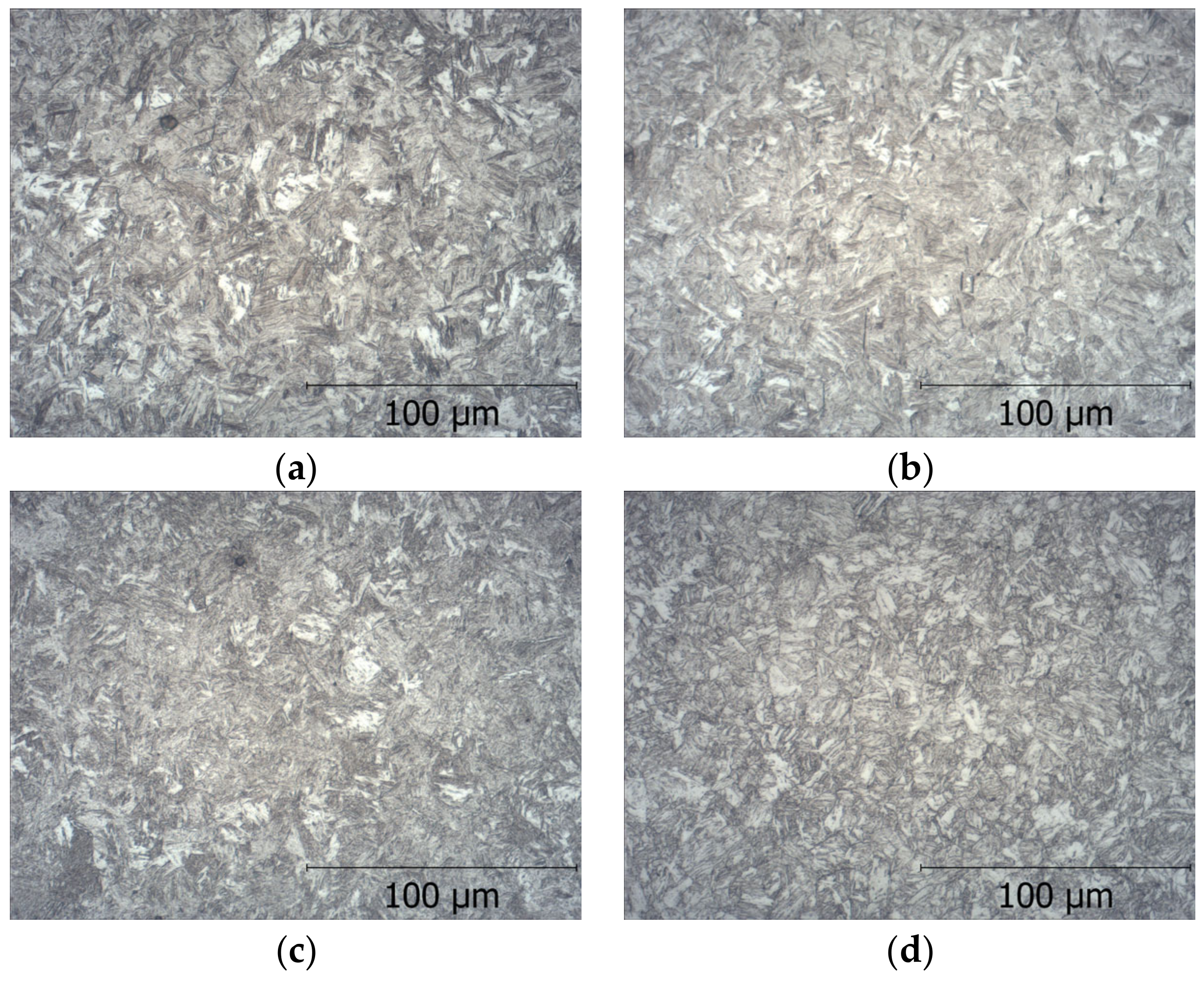
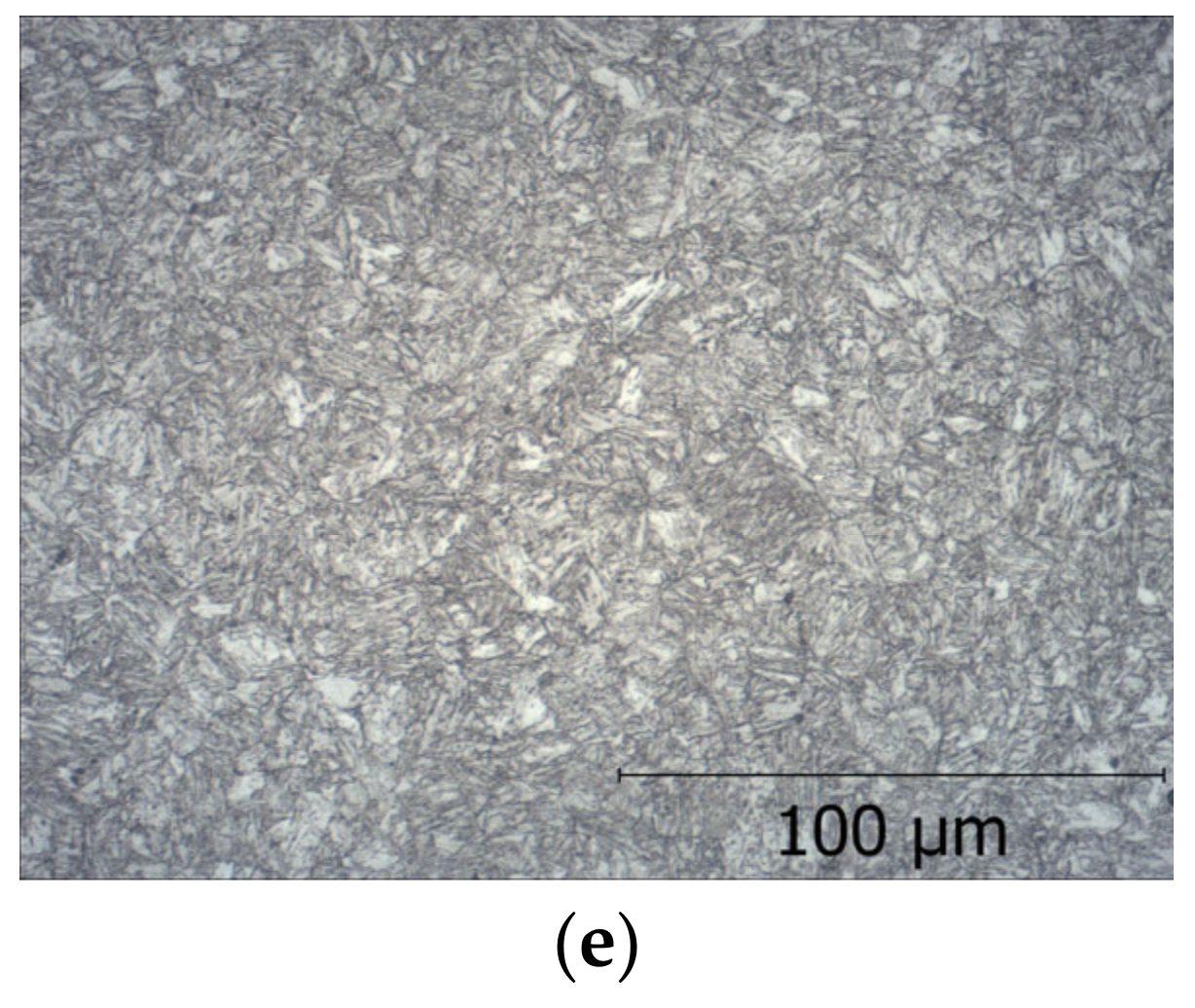
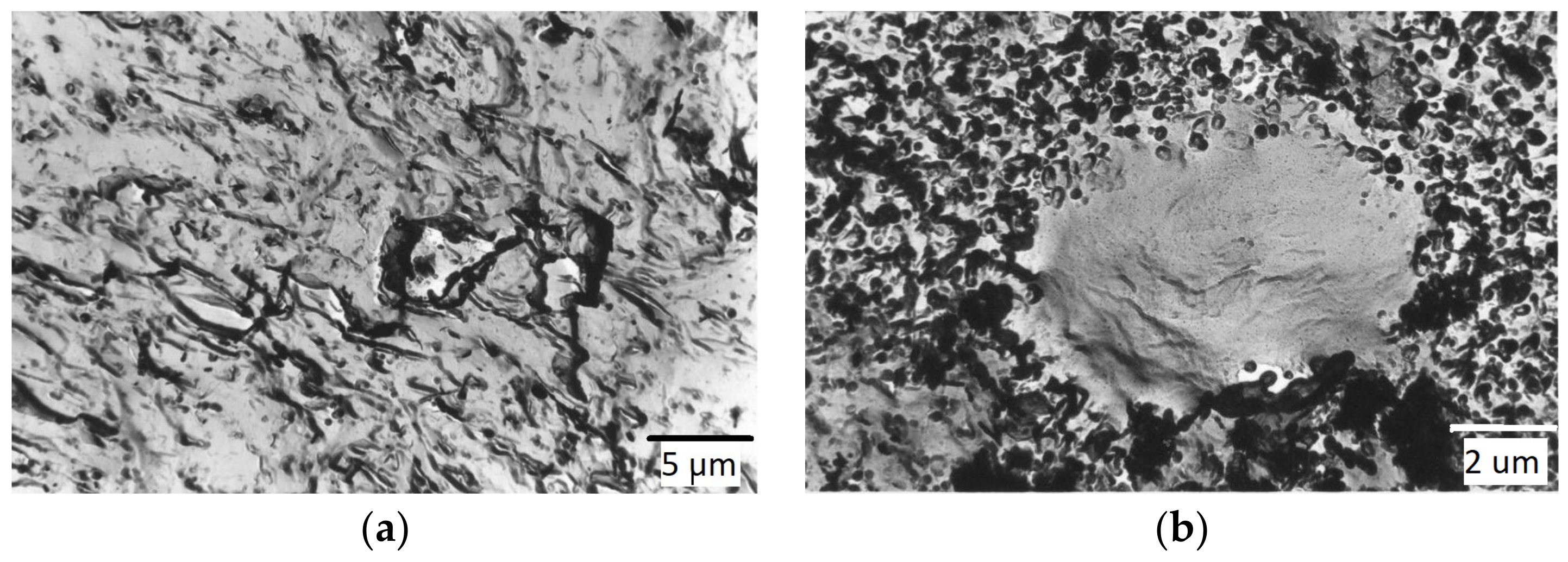
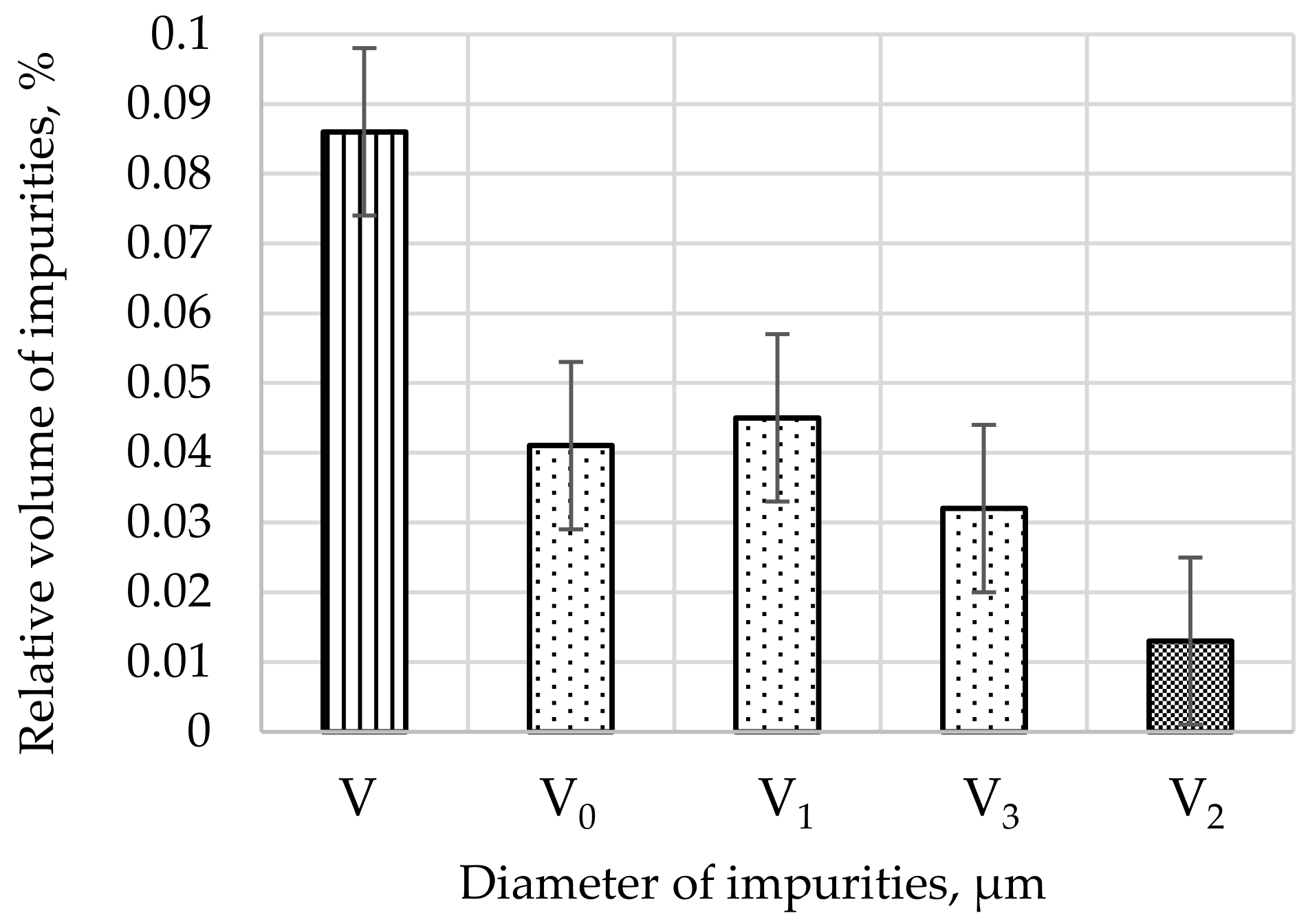
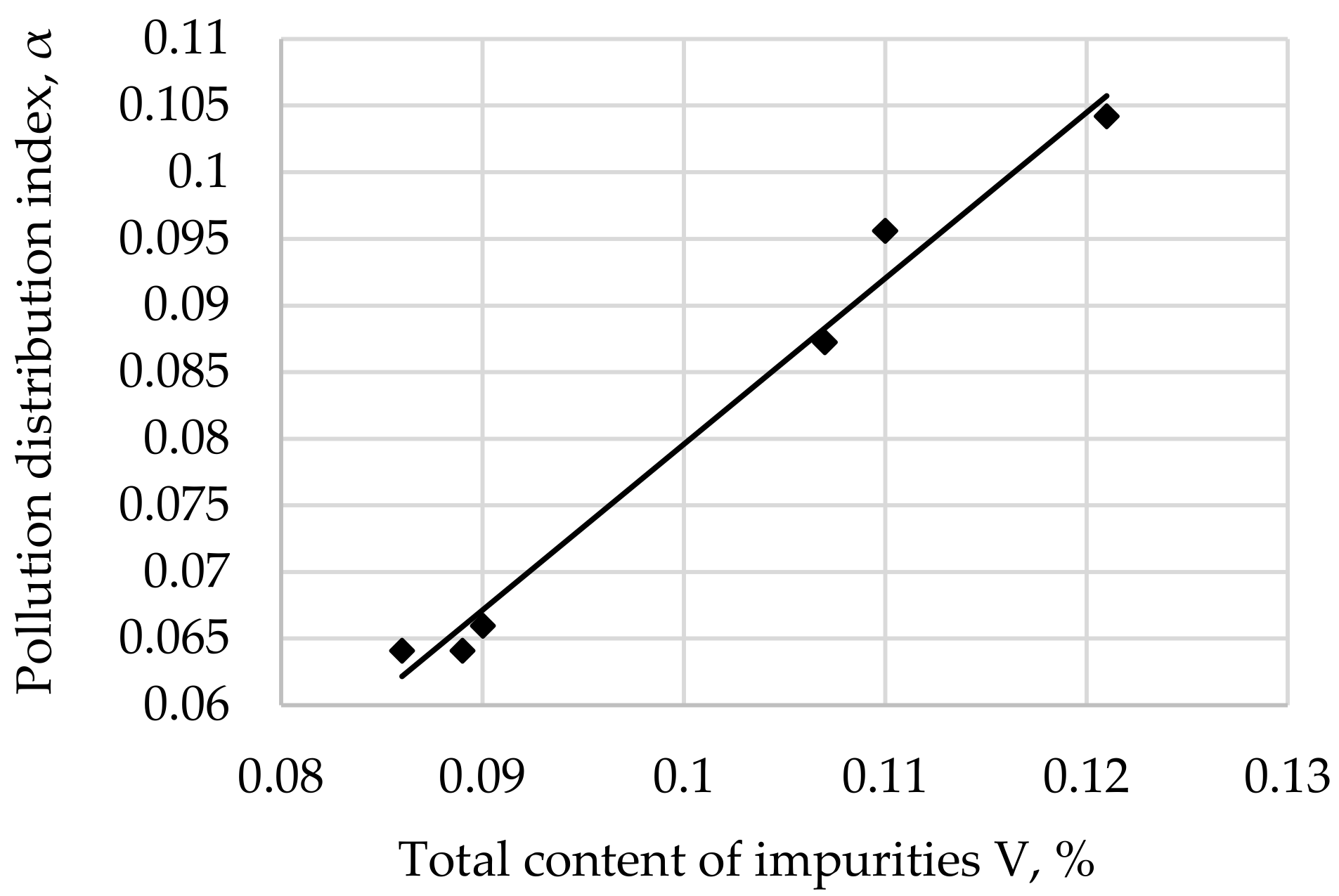

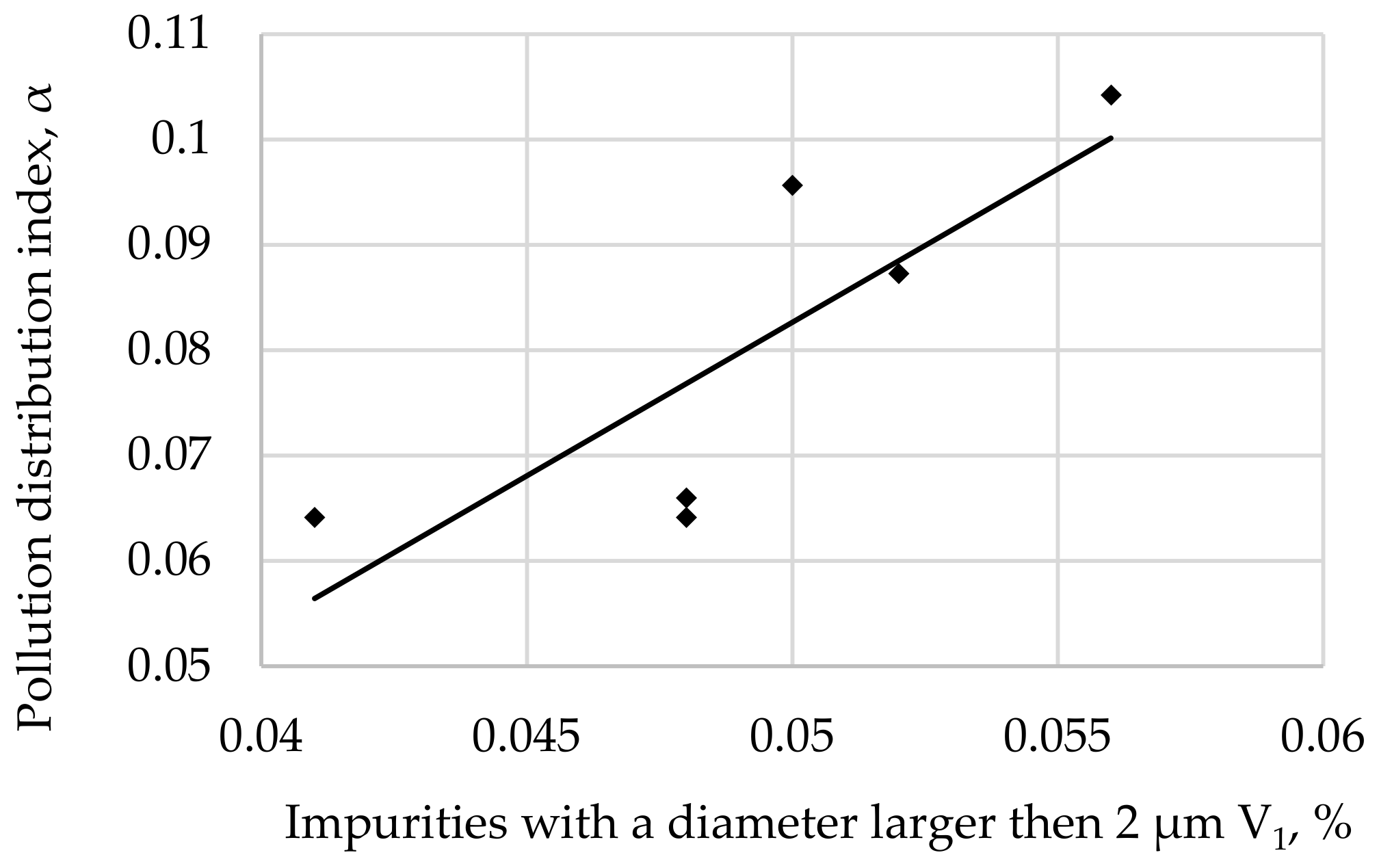

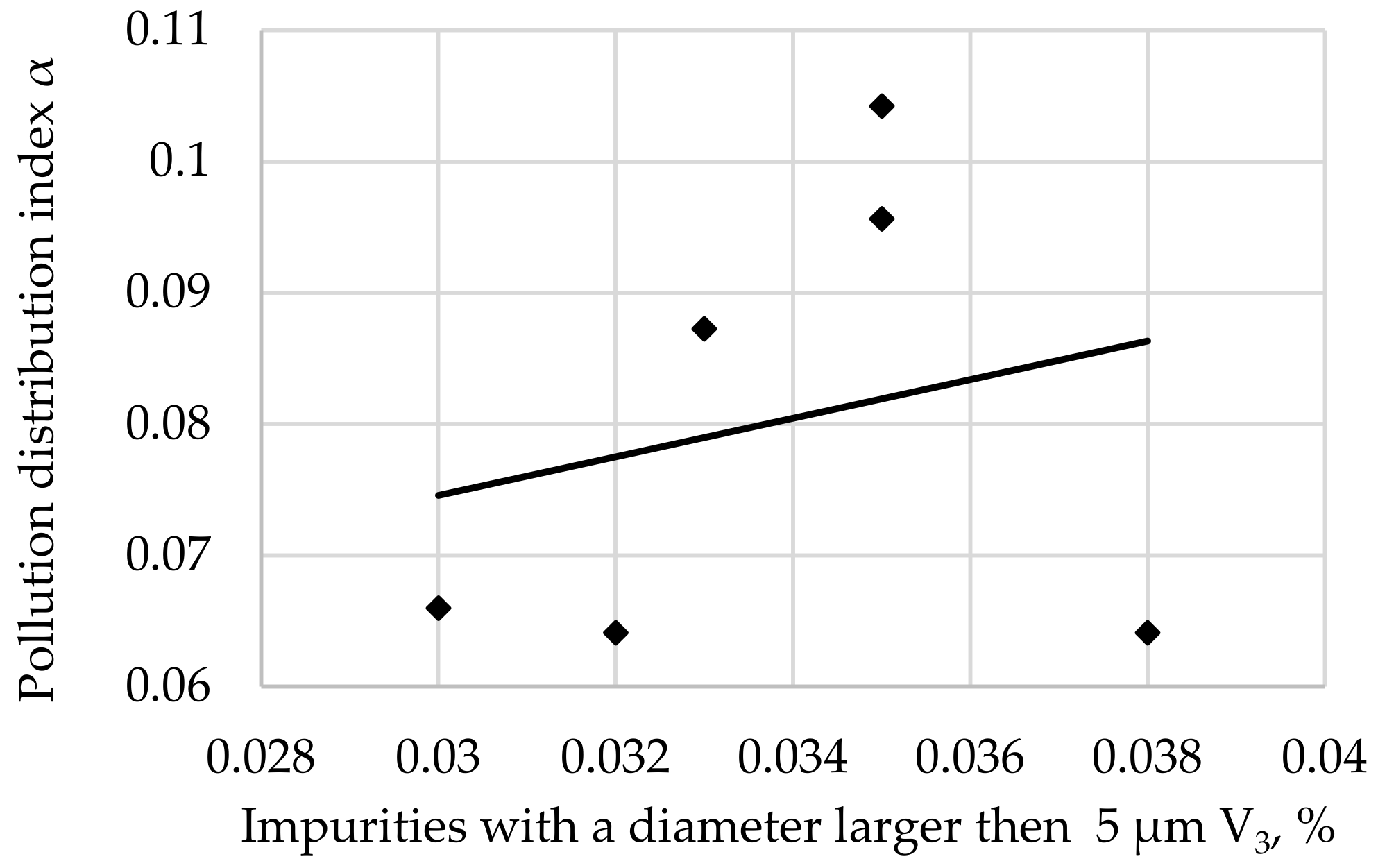
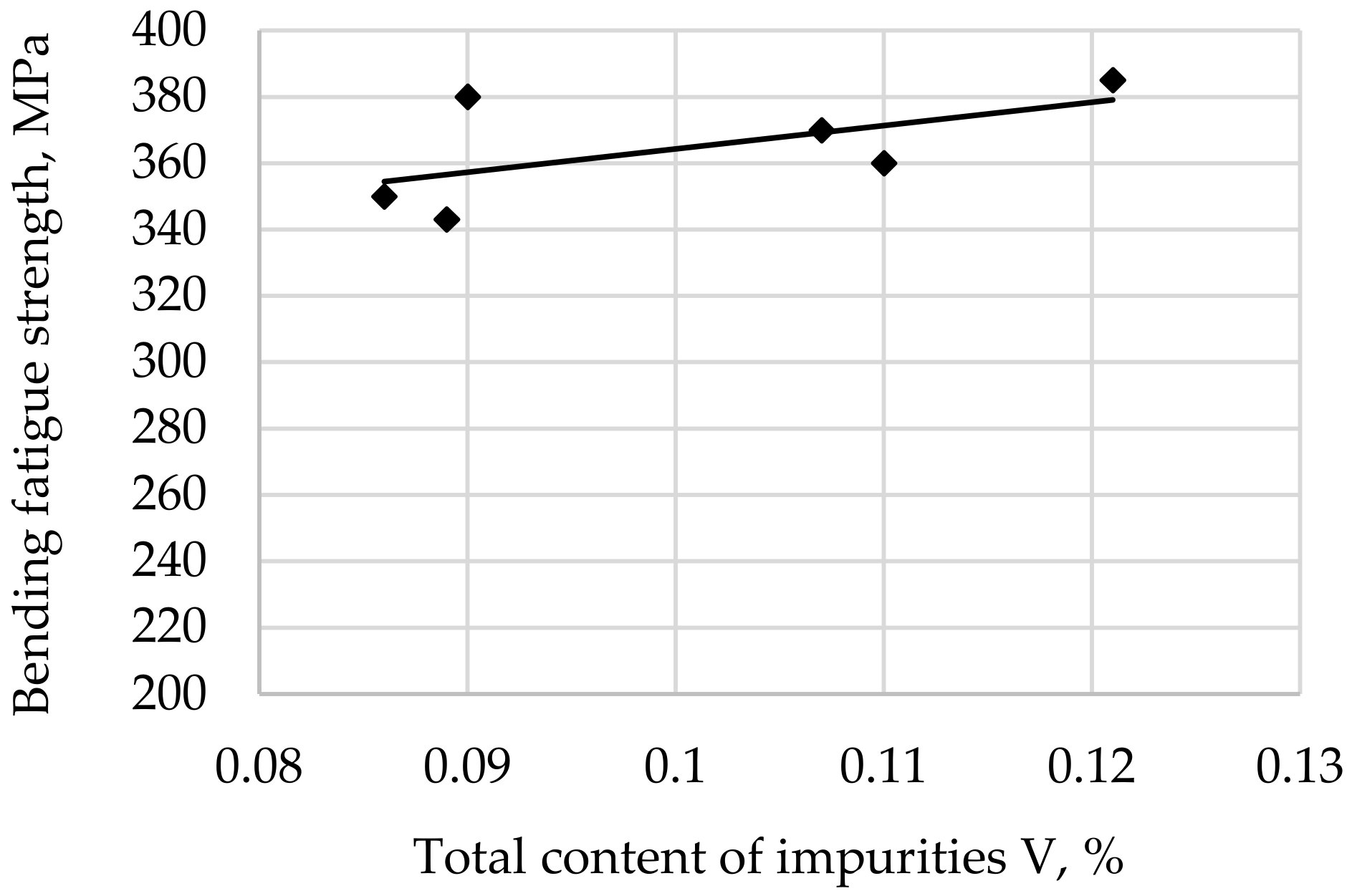
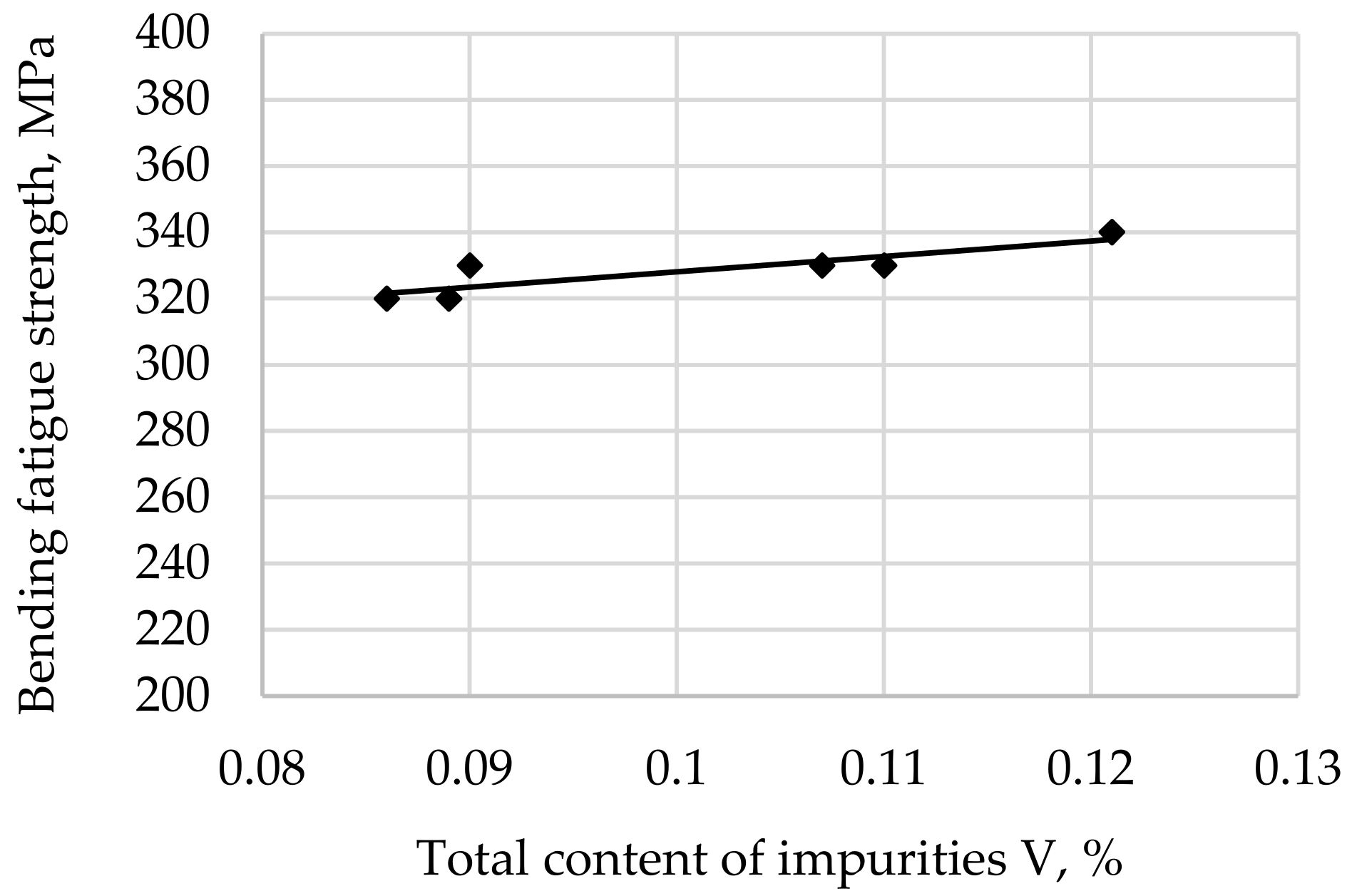
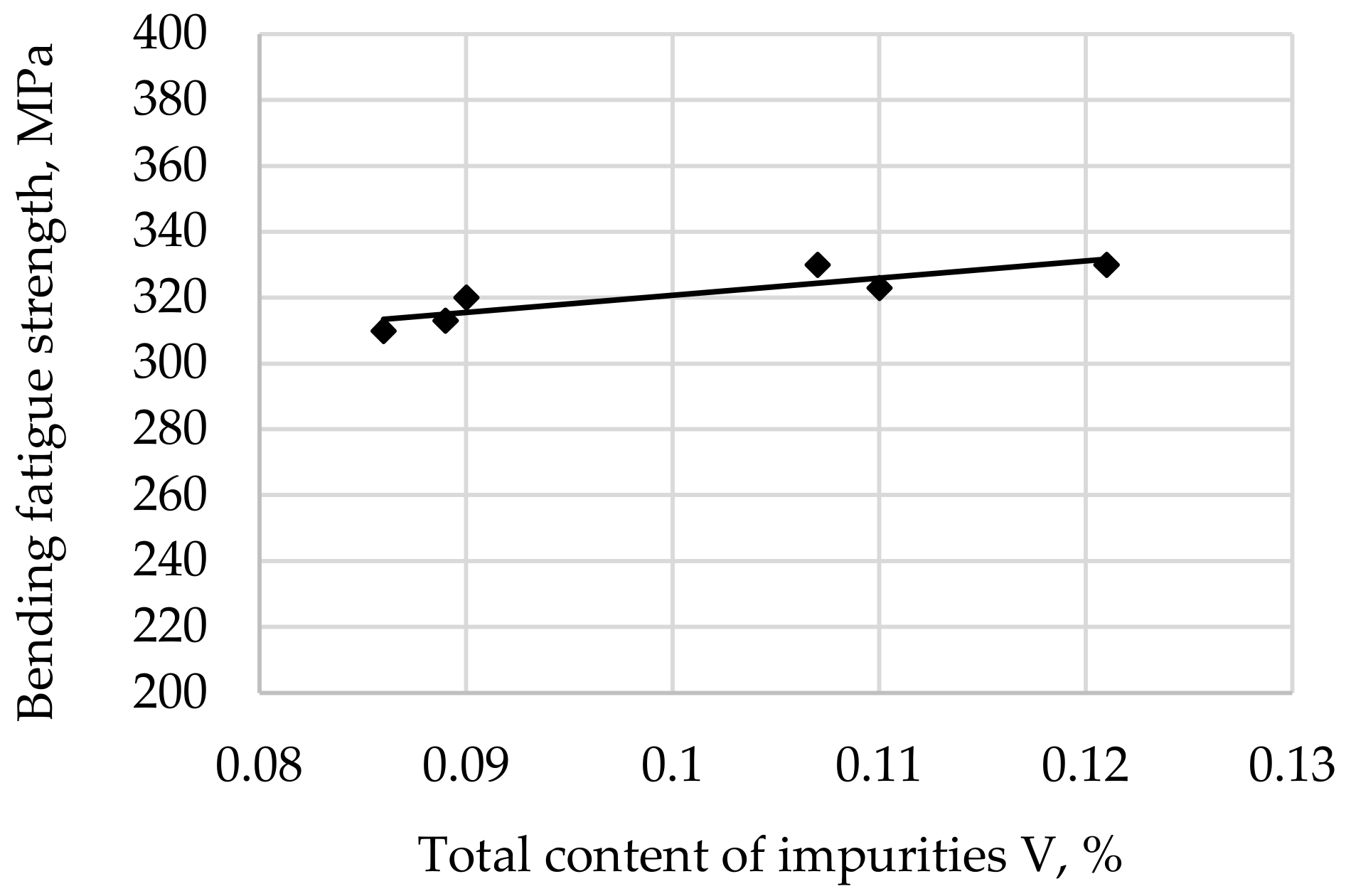
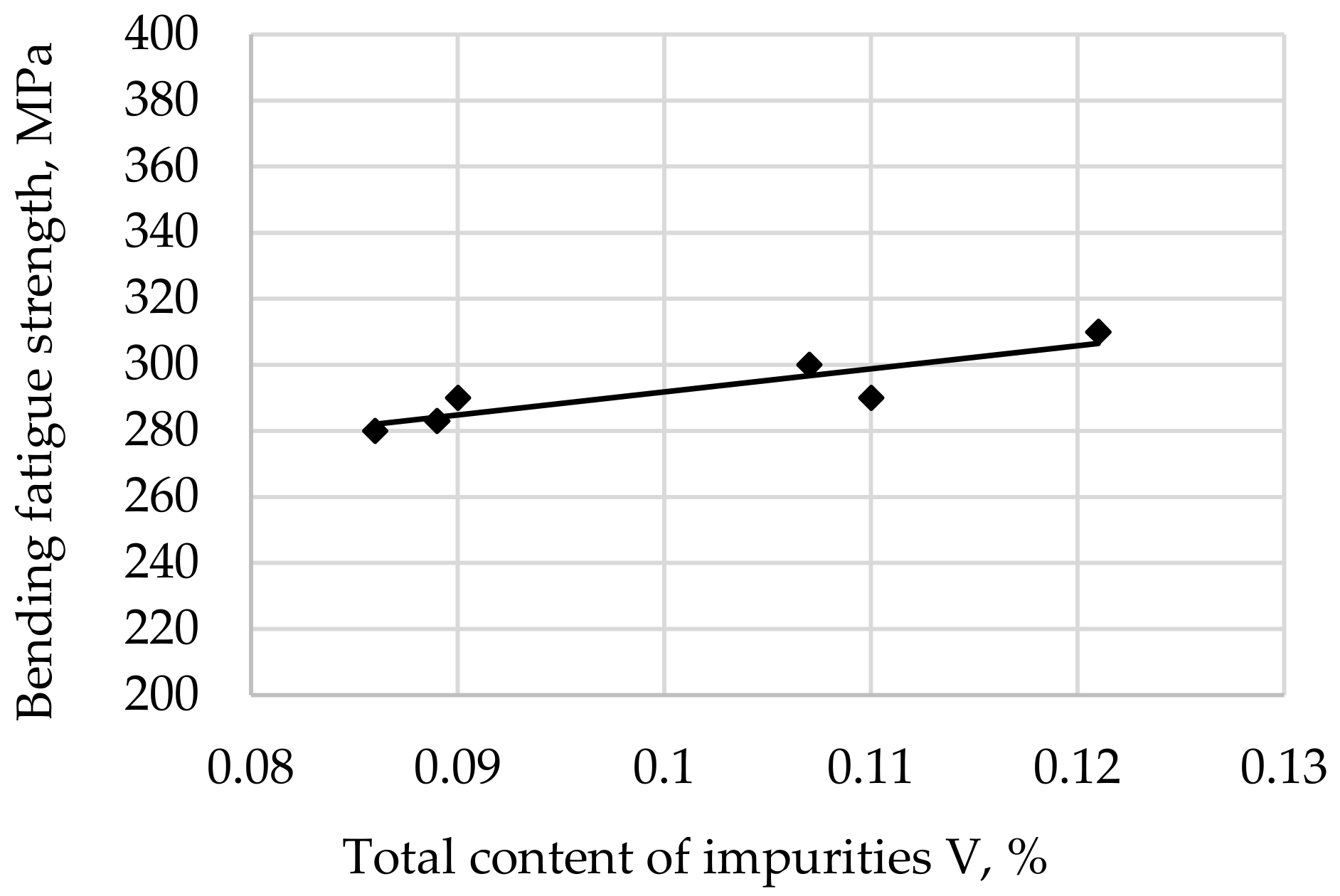
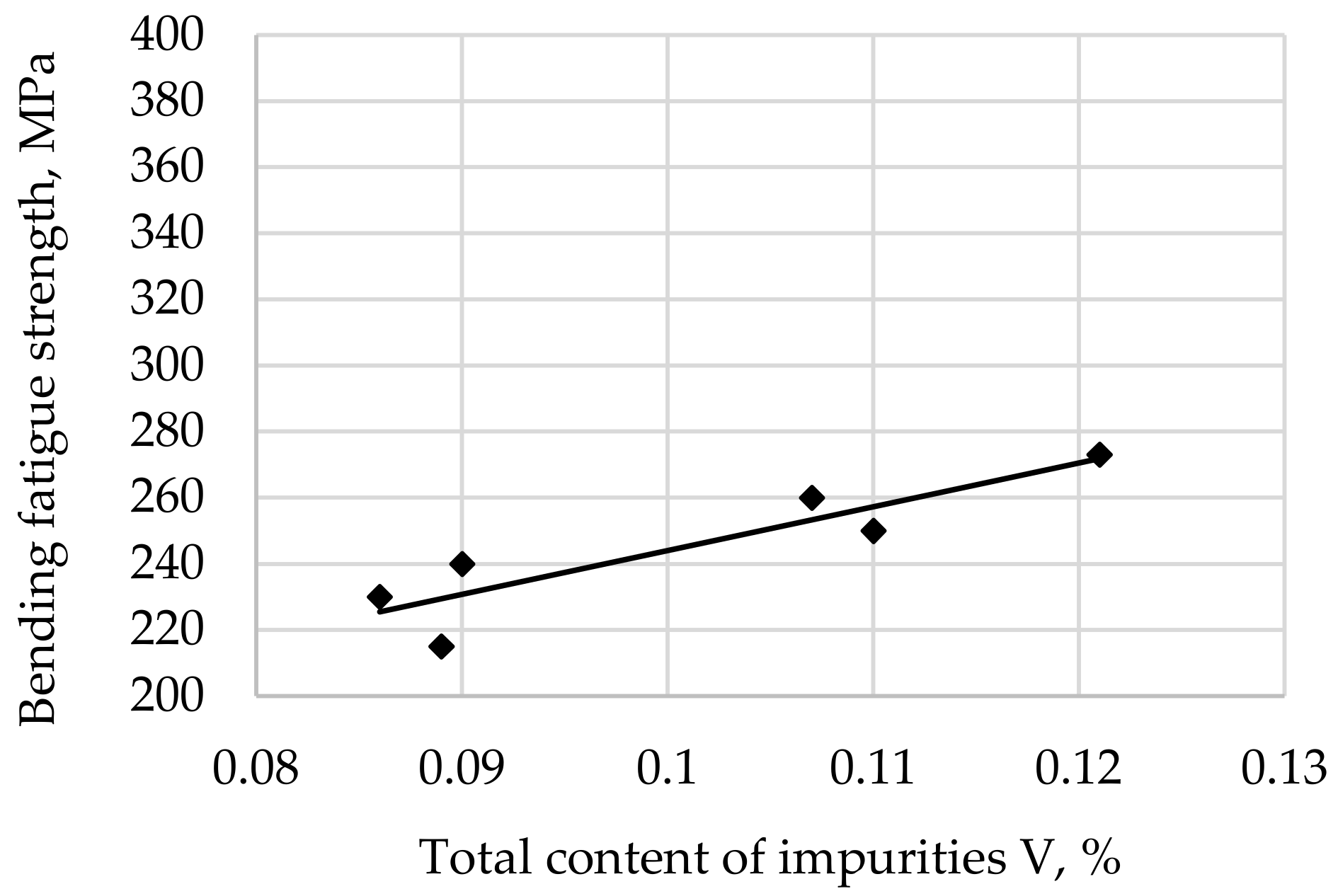
| Chemical Element | C | Mn | Cr | Ni | Mo | Si | Cu | P | S | B |
|---|---|---|---|---|---|---|---|---|---|---|
| wt. % | ||||||||||
| Contents | 0.24 | 1.18 | 0.52 | 0.52 | 0.24 | 0.24 | 0.02 | 0.017 | 0.015 | 0.003 |
| Standard deviation | 0.02 | 0.06 | 0.03 | 0.03 | 0.02 | 0.02 | 0.005 | 0.002 | 0.003 | 0.0005 |
| Diameter of Impurities, µm | Regression Coefficient a (3) | Regression Coefficient b (3) | Correlation Coefficient r | tα = 0.05 Calculated by (5) | tα = 0.05 from Student’s Distribution for p = (n − 1) |
|---|---|---|---|---|---|
| All diameters | 1.2455 | −0.045 | 0.9922 | 17.798 | 2.571 |
| Smaller then 2 µm | 1.6624 | −0.004 | 0.9999 | 158.102 | |
| Larger then 2 µm | 2.9360 | −0.063 | 0.8178 | 3.178 | |
| Between 2 and 5 µm | 2.5269 | 0.0415 | 0.6996 | 2.189 | |
| Larger then 5 µm | 1.4707 | 0.0305 | 0.2302 | 0.529 |
| Tempering Temperature °C | Regression Coefficient a (4) | Regression Coefficient b (4) | Correlation Coefficient r | tα = 0.05 Calculated by (5) | tα = 0.05 from Student’s Distribution for p = (n − 1) |
|---|---|---|---|---|---|
| 200 | 704.13 | 293.90 | 0.6003 | 1.678 | 2.571 |
| 300 | 462.46 | 281.86 | 0.8712 | 3.968 | |
| 400 | 521.13 | 268.63 | 0.8808 | 4.160 | |
| 500 | 696.67 | 222.15 | 0.8866 | 4.286 | |
| 600 | 132.70 | 111.33 | 0.9003 | 4.625 |
Disclaimer/Publisher’s Note: The statements, opinions and data contained in all publications are solely those of the individual author(s) and contributor(s) and not of MDPI and/or the editor(s). MDPI and/or the editor(s) disclaim responsibility for any injury to people or property resulting from any ideas, methods, instructions or products referred to in the content. |
© 2023 by the author. Licensee MDPI, Basel, Switzerland. This article is an open access article distributed under the terms and conditions of the Creative Commons Attribution (CC BY) license (https://creativecommons.org/licenses/by/4.0/).
Share and Cite
Lipiński, T. Quality of Low-Carbon Steel as a Distribution of Pollution and Fatigue Strength Heated in Oxygen Converter. Coatings 2023, 13, 1275. https://doi.org/10.3390/coatings13071275
Lipiński T. Quality of Low-Carbon Steel as a Distribution of Pollution and Fatigue Strength Heated in Oxygen Converter. Coatings. 2023; 13(7):1275. https://doi.org/10.3390/coatings13071275
Chicago/Turabian StyleLipiński, Tomasz. 2023. "Quality of Low-Carbon Steel as a Distribution of Pollution and Fatigue Strength Heated in Oxygen Converter" Coatings 13, no. 7: 1275. https://doi.org/10.3390/coatings13071275
APA StyleLipiński, T. (2023). Quality of Low-Carbon Steel as a Distribution of Pollution and Fatigue Strength Heated in Oxygen Converter. Coatings, 13(7), 1275. https://doi.org/10.3390/coatings13071275






